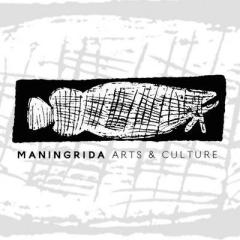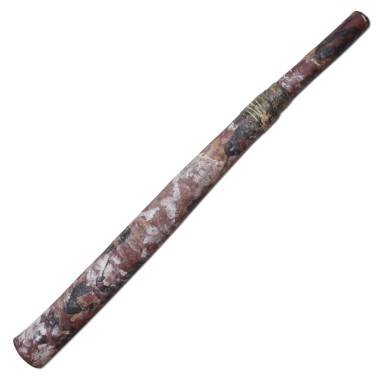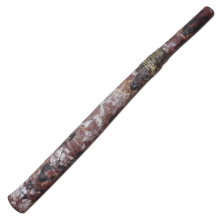Mago Maningrida MN60
Produit plus disponibleMy Comments: Most didgeridoo enthusiasts know about the yidaki and its place in the culture of north-east Arnhem Land. But fewer people have heard of the Mago. The mago is a variant of the didgeridoo, made and used in the western parts of Arnhem Land. The length is made to accompany songs in one of two styles: the bunggurl style of the East or the kunborrk tradition of the West. What is magical with this type of instrument is that it is also possible to play other styles of playing than necessarily the traditional one. This is due to the very good work of the air column. It gives the instrument a full and harmonically rich sound, while still keeping an organic and "termite-like" timbre. I draw your attention to the fact that these instruments are painted with ochre, natural pigments and are not varnished either inside or out. Some may have some small cracks present in the bell, but they are all playable. Keep in mind that these are "Vintages" instruments that are mostly over 40 years old!! It is a real chance to be able to obtain such instruments nowadays!
Following my merger with AborignalArts Uk, I was able to acquire the entire collection of Bear the owner of AborignalArts. Here is a mago made by Ambrose Cameron (Mandilwurra Warray'ngu). In a word... SPECTACULAR! This mago came from the iDIDJ Australia collection before landing at AborignalArts Uk.
Here is simply Guan Ididj Australia's comment regarding this mago:
"This is an old Mago made by Ambrose Cameron from 1998 to 2000, the first instrument I acquired from Ambrose. I immediately recognized the quality of this instrument as it showed signs of wear suggesting it was good enough for community use. Spectacular acoustics with a wide frequency spectrum and full-bodied sound, exceptional resonance, great power, perfect back pressure... What impresses me more than anything else about this Mago is its ability to produce 2 or 3 dominant "sub-harmonics" simultaneously: the high "harmonic" of the tip of the tongue, the mid "harmonic" of the cheeks and the low harmonic of the tip of the tongue. "harmonic" of the back of the throat. Endless possibilities can be offered on this Mago as far as rhythmic compositions and effects are concerned. Another remarkable feature of this Mago is the mouthpiece insert which has been linked to the main sound tube with a string and sealed with beeswax."
Now watch and listen to Darryl Digarrnga testing this mago...
- Shipping costs are free! (only for France)
- The carrying case is offered!
Classification
This scale is the result of an air column/bell start ratio If we divide the diameter of the bell with that of the beginning of the air column we get a number between 1.5 and 3.5. We can classify all the didgeridoos in 4 large families. Each family groups the instruments with a similar character, simply based on the overall shape of the air column (conical/cylindrical) and on the diameter of the column (wide/narrow). The result is a simple and very reliable reading grid, making it easier to search and purchase on line.
The diameters are measured with a caliper, start of the air column after the mouthpîece. This ratio is very reliable for a didg having a air column with a 'smooth' internal work, in the case of a hollowed eucalyptus instrument it give an approach of the instrumental character.

Mago
The Mago is another kind of "traditional" didgeridoo, made of eucalyptus and termite.
The Mago, but what is it?
The mago is a type of traditional didgeridoo from western Arnhem Land. The word is used by members of various language groups whose territory extends from the Gunbalanya (Oenpelli) community in the west, to the River Blythe east of Maningrida and south towards Katherine.
The word mago has become a generic name commonly used for instruments played in the region. Moreover, the use of the word extends beyond the western region of Arnhem Land, as many didgeridoo enthusiasts use the term to refer to traditional didgeridoos made outside of northeastern Arnhem Land—that is, all didgeridoos made in the Top End that are not yidaki.
The name mago is commonly used to identify traditional instruments with shorter, cylindrical shapes.

The characteristics of this style are the drone, devoid of any "toot" or trumpet-like sound, and the melodic harmonic generated by the human voice playing over the drone. Furthermore, mago-type didgeridoos tend to have an open internal column which, combined with the use of the player's vocal cords, lends a melodic character to their sound.
Like other types of traditional instruments, the mago is used as rhythmic accompaniment for traditional songs.
Maintenance: As with yidakis, the mago requires regular, preventative maintenance to last a lifetime! To avoid cracks and allow the wood time to recover its proper moisture content, we recommend referring to the advice and accessories pages.

